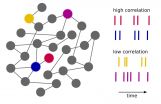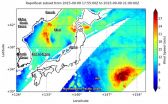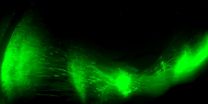Problematic relationship: Small brain models distort contact intensity between neurons
2015-09-10
(Press-News.org) This news release is available in German.
The goal of brain simulations using supercomputers is to understand the processes in our brain. This is a mammoth task: the activity of an estimated 100 billion nerve cells - also known as neurons - must be represented . It is also a task that has historically been impossible because even the most powerful computers in the world can only simulate one percent of the nerve cells due to memory constraints. For this reason, scientists have turned to downscaled models. However, this downscaling is problematic, as shown by a recent Juelich study published in PLOS Computational Biology.
"The challenge of brain simulation is that the nerve cells enter into a temporary relationship with other neurons depending on the task at hand," says Prof. Dr. Markus Diesmann, director of Juelich's institute Computational and Systems Neuroscience (INM-6). Every nerve cell is linked to an average of 10,000 other neurons, which synchronize their activity with each other to varying degrees. The intensity of the relationship between neurons - referred to as correlation - varies depending on the task and the brain areas involved. Using mathematical methods, Dr. Sacha van Albada, research scientist in Markus Diesmann's lab, Dr. Moritz Helias, head of the group Theory of Multi-Scale Neuronal Networks, and Diesmann demonstrated that this correlation cannot be correctly preserved when the number of neuronal connections in a brain model is below a certain level. However, correlations form the basis of frequently used, measurable signals in the brain such as the EEG and the local field potential (LFP).
Each neuron has around 10,000 connections
The information flow in the human brain is extremely complex. Nerve cells exchange information with each other in the form of electrical signals via so-called synapses. Each nerve cell has around 10,000 such connections through which it communicates with other neurons. Just as the motorway network does not determine which car should drive where, data in the brain choose different routes and exits depending on the task. Today's computers cannot process or store such gigantic quantities of information. The number of synapses is therefore reduced in many brain models, which in turn diminishes memory usage.
The Human Brain Project (HBP) aims at detailed simulations of the human brain
Despite these difficulties, the detailed simulation of the entire human brain on a future supercomputer remains the aim of a large-scale scientific project. In the EU-funded Human Brain Project (HBP), neuroscientists and physicists like Markus Diesmann are working together with computer scientists, medical scientists, and mathematicians from over 80 European and international scientific institutions. "Our current research work is a further indication that there is no way around simulating brain circuits in their natural size if we want to gain solid knowledge," says Diesmann.
One of the biggest challenges of the Human Brain Project is the development of new supercomputers. Scientists from Juelich also have a leading role here: the Juelich Supercomputing Centre (JSC) is developing exascale computers to perform the complex simulations in the Human Brain Project. This requires a 100-fold increase in the computing power of today's supercomputers. Next to the mathematical modeling as in the recent study Markus Diesmann and his team therefore work in parallel on the creation of simulation software for the new generation of computers. This work is being performed at the institute Theoretical Neuroscience (IAS-6) and as part of the Neural Simulation Technology Initiative, which provides free access to the software NEST.
INFORMATION:
[Attachments] See images for this press release:

ELSE PRESS RELEASES FROM THIS DATE:
2015-09-10
Japan has experienced large rainfall that caused flooding and large evacuations as a result of two weather systems. NASA's GPM Core satellite measured rainfall as NASA's RapidScat saw Etau and Typhoon Kilo on either side of Japan.
Over the past week Japan has experienced extreme rainfall that resulted in flooding, landslides and many injuries. A nearly stationary front that was already moving over Japan caused much of the rain but Tropical Storm Etau also interacted with the front and magnified the scale of the deluge.
Heavy rainfall led to the evacuation of over one ...
2015-09-10
NEW YORK, NY (September 10, 2015)--Researchers have discovered why long-term use of L-DOPA (levodopa), the most effective treatment for Parkinson's disease, commonly leads to a movement problem called dyskinesia, a side effect that can be as debilitating as Parkinson's disease itself.
Using a new method for manipulating neurons in a mouse model of Parkinson's, a Columbia University Medical Center (CUMC) research team found that dyskinesia arises when striatonigral neurons become less responsive to GABA, an inhibitory neurotransmitter. This suggests that it may be possible ...
2015-09-10
Alexandria, VA - The American Geosciences Institute's (AGI) is pleased to announce the release of a community consensus statement on access and inclusion of geoscientists with disabilities. This statement was inspired by the 2014 AGI Leadership Forum, which brought together the Executive Directors and Presidents of AGI's Member Societies to discuss the issue of access and inclusion of persons with disabilities in the geosciences.
The meeting was facilitated by the Executive Director of the International Association for Geoscience Diversity (IAGD) Christopher Atchison, ...
2015-09-10
NASA's RapidScat instrument analyzed the sustained surface winds of Tropical Storm Henri on Sept. 8 as the storm was intensifying.
When the International Space Station flew over Tropical Depression 8 in the Eastern Atlantic Ocean on September 8 at 1p.m. EDT, NASA's RapidScat instrument aboard captured data on the storm's surface winds. RapidScat showed that there were tropical-storm-force winds north and east of the center near 27 meters per second (60.4 mph/97.2 kph). However, sustained winds on the west and southwestern quadrants were near 12 meters per second (26.8 ...
2015-09-10
September 10, 2015 (Washington) - There are substantial differences among Americans when it comes to knowledge and understanding of science topics, especially by educational levels as well as by gender, age, race and ethnicity, according to a new Pew Research Center report.
The representative survey of more than 3,200 U.S. adults finds that, on the 12 multiple-choice questions asked, Americans gave more correct than incorrect answers. The median was eight correct answers out of 12 (mean 7.9). Some 27% answered eight or nine questions correctly, while another 26% answered ...
2015-09-10
DOWNERS GROVE, Ill.-- September 10, 2015--Having patients lie on their left side while the right side of their colon is being examined can result in more polyps being found, thus increasing the effectiveness of colonoscopy for colorectal cancer (CRC) screening, according to a study in the September issue of GIE: Gastrointestinal Endoscopy, the monthly peer-reviewed scientific journal of the American Society for Gastrointestinal Endoscopy (ASGE).
CRC is one of the most common cancers in the US and other western countries. Studies have shown that deaths from CRC are reduced ...
2015-09-10
Two recently published studies in the journals Age and the British Journal of Nutrition (BJN) demonstrate that consuming cocoa flavanols improves cardiovascular function and lessens the burden on the heart that comes with the ageing and stiffening of arteries. The studies also provide novel data to indicate that intake of cocoa flavanols reduces the risk of developing cardiovascular disease (CVD).
As we age, our blood vessels become less flexible and less able to expand to let blood flow and circulate normally, and the risk of hypertension also increases. Arterial stiffness ...
2015-09-10
This news release is available in German. Protein labeling with synthetic fluorescent probes is a key technology in chemical biology and biomedical research. The target proximity achieved by small-molecule probes is essential to exploit the full potential of super-resolution fluorescence microscopy. Single-molecule localization techniques provide high spatial resolution by reporting on the position of the fluorophore and thus only indirectly on the target molecule itself. Large labels, such as antibodies, can misleadingly position a fluorophore tens of nanometers away ...
2015-09-10
An international research team, which includes NYU anthropologists Scott Williams and Myra Laird, has discovered a new species of a human relative. Homo naledi, uncovered in a cave outside of Johannesburg, South Africa, sheds light on the diversity of our genus and possibly its origin.
"This discovery is unprecedented in the sheer number of hominins collected from such a small area in the virtual absence of other animal remains," says Williams, an assistant professor in NYU's Department of Anthropology. "That makes this site unique. Moreover, the announcement describes ...
2015-09-10
Bethesda, MD (Sept. 10, 2015) -- Detection of small fragments of tumor DNA, known as circulating tumor DNA, in a patient's pre-surgery serum samples predicts early recurrence of hepatocellular carcinoma and may guide treatment, according to a study1 published in Cellular and Molecular Gastroenterology and Hepatology, the basic and translational science journal of the American Gastroenterological Association. Hepatocellular carcinoma -- the most common type of liver cancer -- is the third leading cause of cancer deaths worldwide.
"We uncovered that circulating tumor DNA ...
LAST 30 PRESS RELEASES:
[Press-News.org] Problematic relationship: Small brain models distort contact intensity between neurons




